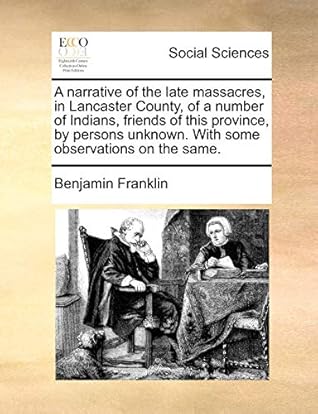A Narrative of the Late Massacres, in Lancaster County, of a Number of Indians, Friends of This Province, by Persons Unknown. with Some Observations on the Same.
by Benjamin Franklin
The 18th century was a wealth of knowledge, exploration and rapidly growing technology and expanding record-keeping made possible by advances in the printing press. In its determination to preserve the century of revolution, Gale initiated a revolution of its own: digitization of epic proportions to preserve these invaluable works in the largest archive of its kind. Now for the first time these high-quality digital copies of original 18th century manuscripts are available in print, making them highly accessible to libraries, undergraduate students, and independent scholars.Delve into what it was like to live during the eighteenth century by reading the first-hand accounts of everyday people, including city dwellers and farmers, businessmen and bankers, artisans and merchants, artists and their patrons, politicians and their constituents. Original texts make the American, French, and Industrial revolutions vividly contemporary.++++The below data was compiled from various identification fields in the bibliographic record of this title. This data is provided as an additional tool in helping to insure edition identification: ++++Library of CongressW017009Generally attributed to Benjamin Franklin. Ascribed to the press of Franklin and Hall by Miller on the basis of the typeface used. Evans, Hildeburn, and P.L. Ford suggest Anthony Armbruster as printer. Sabin says "Written and printed by Franklin." -.[Philadelphia]: Printed [by Franklin and Hall?], in the year M, DCC, LXIV. [1764]. 31, [1]p.; 8
BUY NOW
Paperback, 38 pages
Published June 10th 2010 by Gale Ecco, Print Editions
© 2025 Bibleportal.com 版权所有.

Benjamin Franklin was an important conservative figure in the American Restoration Movement, especially as the leading antebellum conservative in the northern United States branch of the movement. He is notable as the early and lifelong mentor of Daniel Sommer, whose support of the 1889 Sand Creek Declaration set in motion events which led to the formal division of the Churches of Christ from the Disciples of Christ in 1906.
According to contemporary biographies "His early religious training was according to the Methodist faith, though he never belonged to any church until he united with the Disciples."
In 1856, Franklin began to publish the ultra-conservative American Christian Review, which he published until his death in 1878. Its influence, initially considerable, was said to have waned following the American Civil War. Franklin undertook a rigorous program of publication correspondence, and traveling lectures which took him to "many" U. S. states and Canada.
Franklin's last move was to Anderson, Indiana, where he lived from 1864 until his death.
... Show more